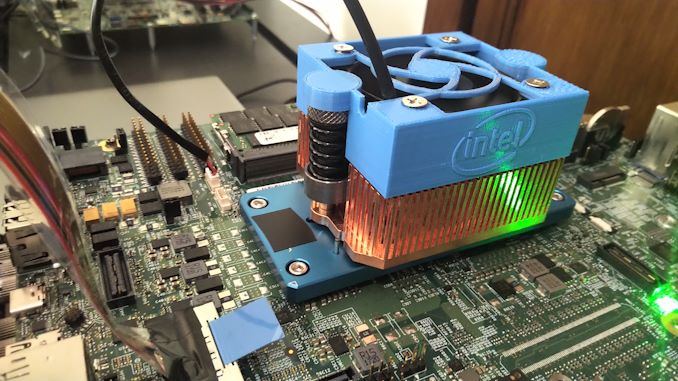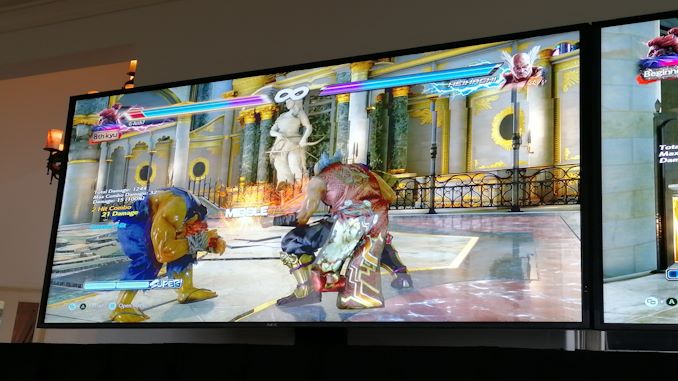Intel's Architecture Day 2018: The Future of Core, Intel GPUs, 10nm, and Hybrid x86
by Dr. Ian Cutress on December 12, 2018 9:00 AM EST- Posted in
- CPUs
- Memory
- Intel
- GPUs
- DRAM
- Architecture
- Microarchitecture
- Xe
Demonstrating Sunny Cove and Gen11 Graphics
As part of the Architecture Event, Intel ran a number of demos on a chip that was supposedly based on the new Sunny Cove cores and Gen11 graphics.
These were development systems with these funky looking heatsinks and loud fans to ensure there was no thermal throttling. One thing worth noticing is that black bit of tape on the heatsink here, which wasn’t present on one of the other demo units.
Hello Ice Lake-U. Being a U-series heatsink, this means that the Core is likely designed for a 15W scenario.
Perhaps it’s no surprise that Intel wasn’t giving anything away in terms of the exact core count on display, speeds, feeds, and power. The demos that were present involved 7-Zip and gaming.
The 7-Zip demo was relatively straight forward, showing how the new instructions such as Vector-AES and SHA-NI in Sunny Cove can give the processor a 75% boost in performance over an equivalent Skylake based platform at iso-frequency. This falls under the ‘specialist’ improvements to the core rather than the general purpose improvements.
The other demo was Tekken 7, being run on a Sunny Cove + Gen11 machine and compared to a Skylake + Gen9 implementation. It looked a good deal smoother that’s for sure, however it was clear that it had some way to go to be fully out of the 30 FPS minimums.














148 Comments
View All Comments
Spunjji - Thursday, December 13, 2018 - link
Is it better? Their last roadmaps were not worth the powerpoint slides they showed up in, not to mention the whole "tick-tock-optimise-optimise-delay" fiasco.HStewart - Thursday, December 13, 2018 - link
From the look of things in this excellent article - it looks for 2019 Intel is combining both tick and tock together with significant architexture improvement along with process improvements.johannesburgel - Thursday, December 13, 2018 - link
Compared to the latest Xeon roadmaps I have seen in NDA meetings, these desktop roadmaps still seem quite ambitious. They don't expect to ship a "lower core count" 10nm Xeon before mid-2020.HStewart - Thursday, December 13, 2018 - link
Just because Intel did not mention it - does not mean it will not happen.Also remember that Intel is decoupling the process from actual Architexture. In the past, I alway remember the Xeon technologies were forerunner's of base core technology. Hyperthreading is one example and multiple core support.
Vesperan - Wednesday, December 12, 2018 - link
Its 6am for me, and with the mugshots of Jim Keller and Raja Koduri at the end you could have labelled this the AMD architecture day and I would have believed you. It will be an interesting several years as those two put their stamp on Intel CPU/GPUs.The_Assimilator - Wednesday, December 12, 2018 - link
So Intel is going to take another poke at the smartphone market it seems. Well, let's hope Fovoros fares better than the last half-dozen attempts.Rudde - Wednesday, December 12, 2018 - link
7W is too much for a smartphones power budget. Smartphones operate at sub 1W power budget.johannesburgel - Wednesday, December 12, 2018 - link
The just announced Qualcomm Snapdragon 855 has a peak TDP of 5 Watts. Most smartphone manufacturers limit the whole SoC to 4 watts. The average smartphone battery now has >10 Wh, so even at full load the device would still run between 1.5 (display on) and 3 (display off) hours. Which it has to in the hands of those gamer kids.YoloPascual - Wednesday, December 12, 2018 - link
Had the og zenfone with the intel soc. It drains battery as a gas guzzler suv. Never buying a smartphone with intel inside ever again.Mr Perfect - Wednesday, December 12, 2018 - link
It's exciting to see Intel use FreeSync in their graphics. They could have easily gone with some proprietary solution, then we'd have three competing monitor types. Hopefully having both AMD and Intel on FreeSync will prompt Nvidia to at least support it alongside G-Sync.